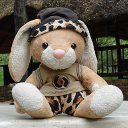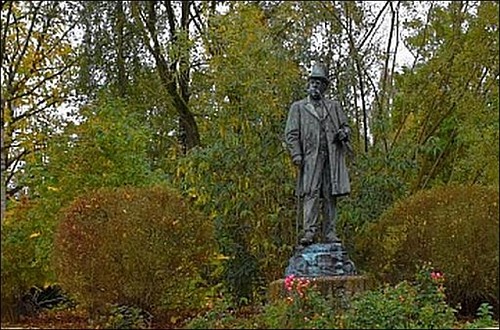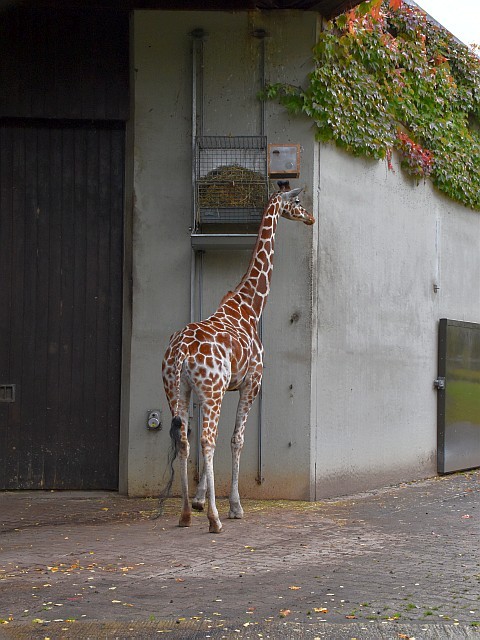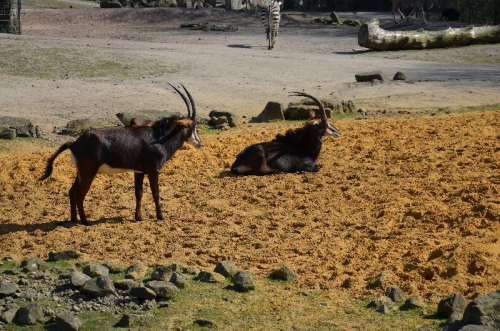
1575 posts
Mnster: Allwetterzoo
Münster: Allwetterzoo
- Deutsch/German-
Auf den, im Westen vor der Stadtbefestigung liegenden, Aawiesen befand sich im 19. Jahrhundert ein Sommertheater, das auf einer kleinen Insel lag. Ein romantisches, idyllisch gelegenes Gelände, wo die Aa in die Stadt eintritt. Eine Brücke gab es nicht; nur mit einem Kahn konnte die Insel erreicht werden.

Genau diese Stelle hatte sich der legendäre Professor Hermann Landois für die Gründung des Zoos ausgesucht. Landois war Priester, Zoologe und vor allen Dingen ein besonders kreativer Mensch - und auch ein etwas skurriler Kauz.

Sein Ziel war es, die Forschungsergebnisse und das Wissen über die heimische Tierwelt der Bevölkerung nahezubringen. 1871 war es dann soweit: der ,Westfälische Verein für Vogelschutz, Geflügel- und Singvogelzucht' wurde gegründet.

Bereits 1873 wurde beschlossen, einen zoologischen Garten zu errichten. Die von Landois vorgesehene kleine Insel an der Aa konnte im Februar 1874 erworben werden. Etwas später kaufte der Verein auch die angrenzenden Aawiesen hinzu, die für den Ausbau der Anlage notwendig war.

Ende des 19. Jahrhunderts gab es bereits viele Tierstationen, wie zum Beispiel den Bärenkäfig, das Löwenhaus, das Aquarium, das Elefantenhaus. Auch in den weiteren Jahren wurde der Tiergarten ständig weiter ausgebaut.

Dann gab es die so genannten Völkerschauen, in den Menschen aus Afrika und anderen Regionen der Erde gezeigt wurden. Diese “Vorführungen” hatten regen Zulauf und brachten Geld für das Zooprojekt. Über diese äußerst zweifelhaften und unrühmlichen Veranstaltungen machte man sich damals wenig Gedanken.

Bei den Bombenangriffen in den letzten Kriegsjahren des WW II wurden fast alle Tiere getötet. Zwei überlebende Elefanten mussten 1945 als Reparationsgut an den Antwerpener Zoo abgegeben werden. Der Großteil der Zoogebäude war vernichtet. Es begann ein mühsamer Wiederaufbau.

1950 bekam der Zoo wieder einen Elefanten, der in das nur leichtbeschädigte Elefantenhaus einziehen konnte. Zum 75jährigen Bestehen im Jahre 1950 zeigte der Zoo wieder ein eindrucksvolles Bild. Aber das 100jährige Jubiläum wurde bereits an anderer Stelle gefeiert: im neuen Allwetterzoo.

Für die Haltung der Tiere konnten beim Neubau modernste und neueste tiergärtnerische Erkenntnisse zugrunde gelegt werden, die im alten Zoo nicht möglich gewesen wären. Ein neues Gelände war bereitgestellt worden, stadtauswärts am südlichen Teil des Aasees.

Der 1974 eröffnete Allwetterzoo erlaubt einen Besuch bei fast jedem Wetter und war damals in seiner Bauweise revolutionär. Der namensgebende Allwettergang ermöglicht es bei schlechtem Wetter, einen Teil der Tiere trockenen Fußes zu erreichen.

Er verbindet die Tierhäuser mit einem überdachten Weg. Dieser 1 Kilometer Rundweg (auch Regenweg genannt) führt leider nicht an den großen Freianlagen vorbei, es kann also durchaus sein, dass der Regenweg nicht den Erwartungen entspricht. Außerdem schützt der Allwettergang nicht gegen Wind und Kälte.

Der große Rundweg, der 5 Kilometer “Sonnenweg”, führt durch den gesamten Zoo und ist leider nur bedingt rollstuhltauglich. Entweder kommen unerwartet Treppen in die Quere oder Rindenmulchwege erschweren das Vorwärtskommen.

Der Allwetterzoo bietet dem Besucher einiges: Begehbare Freianlagen und Volieren, das Westfälische Pferdemuseum mit Original-Exponaten zur Geschichte des Pferdes in Natur und Kultur, etliche Spielplätze für Kinder und eine Tropenhalle mit freifliegenden Vögel.

Die Delfinhaltung wurde 2013 aus Kostengründen aufgegeben und das ehemalige Delfinarium dient nun als Robbenhaven und als Showbühne für die kalifornischen Seelöwen.

Der Allwetter-Zoo bietet einige interessante Tieranlagen, beispielsweise für Erdmännchen, Nashörner und Elefanten und auch das Aquarium ist einen Besuch wert.

Die Highlights für große & kleine Besucher:
Lori Besucher Fütterung
Pinguin Besucher Fütterung
Pinguinmarsch durch den Zoo
Elefanten Besucher Fütterung
Tierpflegergespräche

Störend am Zoo sind leider heute die 70er-Jahre-Betongebäude und der Allwettergang. Aber es sind Verbesserungen ersichtlich, um das Erscheinungsbild des Zoos zu modernisieren.

Die Gastronomie ist leider auch völlig unkreativ und unattraktiv, dabei hat doch gerade das Münsterland viel mehr zu bieten als Pommes und Currywurst. Hier ist irgendwie auch alles noch in den 70ern stecken geblieben.

Preise / Tagestickets Sommer:
Erwachsene 18,90 € Schüler/Studenten (mit Ausweis) 12,90 € Kinder (von 3 – inkl. 14 Jahren) 10,90 € Begleitperson (bei Ausweis-Eintrag „B“) frei
Preise / Tagestickets Winter:
Erwachsene 14,90 € Schüler/Studenten (mit Ausweis) 9,90 € Kinder (von 3 – inkl. 14 Jahren) 8,90 € Begleitperson (bei Ausweis-Eintrag „B“) frei
Für den Parkplatz werden üppige 4 Euro verlangt!

-
 logi1974 liked this · 2 years ago
logi1974 liked this · 2 years ago -
 janwo liked this · 5 years ago
janwo liked this · 5 years ago
More Posts from Logi1974
Gelsenkirchen: Zoom
-english-
The city of Gelsenkirchen already had zoological garden 130 years ago. In 1889 Karl Cofflet decided to turn his property in Gelsenkirchen into an animal park.

He opened a tavern in 1889 and used the proceeds to gradually introduce the visitors to exotic animals as well as mongooses, macaque monkeys or some snakes.

70 years ago, the Ruhr Zoo opened then in the green area of Bismarckhain, the green area south of the Rhein-Herne-Channel, which wrote local zoo history.

Around 20 million guests visited the Ruhr Zoo in the first 40 years and admired many innovations: in 1952, the Great Ape House was opened, and the first orangutans moved in.

The animals vegetated in much too small and not very natural designed cages to themselves. Concrete and steel were the most used building materials. The wild cats paced back and forth in their cages, always facing the gaze of the visitors.

The elephants also only had a minimalist area and often stood in the same place for a long time, shifting their weight from one leg to the other and swinging their heads and their trunk from one side to the other.

Over the years, the Ruhr Zoo became less and less contemporary and less attractive. With the absence of visitors but also the problems were getting bigger. In 1987, the Zoo Foundation Association was founded.

The former Ruhr Zoo was completely renovated in the past decade (more or less razed to the ground) and renamed "Zoom Erlebniswelt" (Zoom adventure world).

Today, the Zoom Erlebniswelt offers more than 800 animals and 23 species of animals over an area of more than 30 hectares. The zoom world is divided into three thematic areas: Alaska, Africa and Asia.

At the entrance arised the "Grimberger Hof" with beer garden, petting zoo, climbing playground and rare German livestock such as Danish Protest Pig or the Hinterwald Cattle.

Alaska gives you an insight into the different vegetation zones of North America: the 1.3 kilometer circular trail leads us from the coastal rainforests over the tundra and the rocky mountain landscape to the polar region.

At least as exciting is the abandoned mine directly opposite the bear enclosure. Once upon a time, the gold diggers must have dug for their luck here.

The landscapes and enclosures are perfectly designed to the theme and come up with many small details. We walk like adventurers between rocks and rivers. Waterfalls with adventurous suspension bridges doing a spectacular scenario for the bears and for us to watch.

Special features here include the underwater glass tunnel in the basin of the California Sea Lions and the 3,000 m² bear complex that shows Polar, Kamchatka and Kodiak bears.

The safari through Africa takes us, next to the lions first, over a total distance of 1.8 kilometers. However, they have made themselves quite comfortable and doze well camouflaged in their enclosure.

Africa shows a village with domestic breeds, savanna scenery and the rainforest. A boat trip leads around the baboon rocks and along the different landscape enclosures.

The vast savanna with zebras, various gazelles and antelopes seemed endless. This impression is supported by the fact that it pulls along a slight slope, so that the otherworldly boundary isn´t visible to fast.

There is also an island where you walk through the enclosure of a group of lemurs, completely fenced off. If you do not like it, you can alternatively choose the path around the enclosure.

Asia is the youngest area with jungles, orangutans and many small Asian animals. A 1,300-meter-long promenade, sometimes even 5 meters in the height, meanders through the jungle. In addition, there is an indoor playground and a food court, which also served evening hours.

The gastronomy doesn´t stands out despite thematic naming, for example Africa Lodge or Alaska Diner, from the usual average offer.

Prices / Day ticket summer: Adults € 21.50 Children (4 to 12 years) 14,00 € Pupils and students with valid ID 16,00 € Dogs 6,00 € Prices / day ticket winter: Adults € 15.50 Children (4 to 12 years) 10,50 € Students and students with valid ID 12.50 € Dogs 5.00 € For the parking lot 6 Euro are cheekily charged as a daily rate!


So, what are you waiting for? Go camping in style in Namibia and remember to check out the various Gondwana campsites.
Münster: Allweather-Zoo
-english-
In the 19th century, on the west side of the town fortifications, were the meadows of the Aa river. Situated on a small island was a summer theater . A romantic, idyllic area where the river Aa enters the city. There was no bridge; only with a boat could the island be reached.

Exactly this place had chosen the legendary Professor Hermann Landois for the founding of the zoo. Landois was a priest, zoologist and, above all, a particularly creative person - and also a bit of a bizarre owl.

His goal was to bring the research results and knowledge of the local wildlife to the residents. In 1871 it was time: the "Westphalian Association for bird protection, Poultry and songbird breeding" was founded.

Already in 1873 it was decided to build a zoological garden. The by Landois selected small island on the Aa was acquired in February 1874. A little later, the Association also bought the adjacent meadows, which was necessary for the expansion of the estate.

By the end of the 19th century, there were already many animal stations, such as the bear cage, the lion house, the aquarium and the elephant house. Also in the following years the zoo was constantly expanded.

Then there were the so-called "Ethnological Expositions" in which people from Africa and other regions of the world were shown. These "demonstrations" were very popular and brought money for the zooproject. At that time, little thought was given to these extremely dubious and inglorious events.

Almost all the animals were killed in the bombing raids during WWII's last war years. Two surviving elephants had to be delivered in 1945 as reparations to the Antwerp Zoo. Most of the zoo buildings were destroyed. It began a laborious reconstruction.

In 1950, the zoo again got an elephant, which was able to move into the only slightly damaged elephant house. For the 75th anniversary in 1950, the zoo again showed an impressive picture. But the 100th anniversary has already been celebrated elsewhere: in the new all-weather zoo.

For the keeping of the animals, the new building could be lean on state-of-the-art animal husbandry findings that would not have been possible in the old zoo. A new site had been provided, out of town on the southern part of the lake.

Opened in 1974, the all-weather zoo allows to visit it at almost every weather conditions and was revolutionary in its construction at that time. The eponymous all-weather-route makes it possible to reach a part of the animals in bad weather with dry feet.

He connects the animal houses with a covered path. This 1 kilometer circular route (also called rain route) unfortunately does not lead past the large open enclosures, so it may well be that the rain route does not meet expectations. In addition, the all-weather gear does not protect against wind and cold.

The large circular route, the 5 kilometer "sun path", leads through the entire zoo and is unfortunately only partially wheelchair accessible. Either stairs get in the way unexpectedly or bark mulch paths make it difficult to move forward.

The all-weather zoo offers visitors a lot: walk-in open spaces and aviaries, the Westfälische Pferdemuseum ( Westphalian Horse Museum) with original exhibits on the history of the horse in nature and culture, several playgrounds for children and a tropical hall with free-flying birds.

The keeping of the dolphins was abandoned in 2013 for cost reasons and the former dolphinarium now serves as "Robbenhaven" (seal habor) and as a show stage for the Californian sea lions.

The all-weather zoo offers some interesting wildlife enclosures, such as meerkats, rhinos and elephants, and the aquarium too is well worth a visit.

The highlights for the grown up and small visitors: - Lori visitors feeding - Penguin visitor feeding - Penguin march through the zoo - Elephant visitors feeding - zookeeper talks

The disturbing things about the zoo is unfortunately the 1970s concrete buildings and the all-weather aisle. But improvements to modernize the zoo's image are recognizable.

The gastronomy is unfortunately also completely uncreative and unattractive, yet just the Münsterland has much more to offer than fries and curry-sausage. Somehow everything here got stuck in the 70s as well.

Prices / Day tickets Summer: Adults 18,90 € Pupils / students (with ID) 12,90 € Children (from 3 - incl. 14 years) 10.90 € Accompanying person (with ID entry "B") free Prices / day tickets winter: Adults € 14.90 Pupils / students (with ID) 9.90 € Children(from 3-incl.14 years) 8.90 € Accompanying person (with ID entry "B") free For the parking lot luxuriantly 4 euros are required!


Ideas for Christmas gifts in Namibia

What do you look forward to doing outdoors this spring?